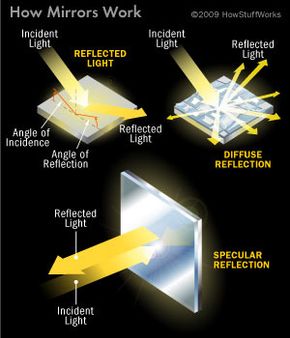Mirror Physics
In order to understand mirrors, we first must understand light. The law of reflection says that when a ray of light hits a surface, it bounces in a certain way, like a tennis ball thrown against a wall. The incoming angle, called the angle of incidence, is always equal to the angle leaving the surface, or the angle of reflection. When light hits a surface at a low angle -- like on a lake at sunset -- it bounces off at the same low angle and hits your eyes full blast, rather than obliquely as when the sun sits overhead. This is why the sun's glare during the evening and morning is so much more intense than during the rest of the day.
Light itself is invisible until it bounces off something and hits our eyes. For instance, a beam of light traveling through space can't be seen from the side until it runs into something that scatters it, like a cloud of hydrogen or a satellite. This scattering is known as diffuse reflection and this is how our eyes interpret what happens when light hits an uneven surface. The law of reflection still applies, but instead of hitting one smooth surface, light is hitting many microscopic surfaces. It's more like throwing a handful of marbles against a statue and then guessing the statue's shape based on how the marbles bounce.
Advertisement
Mirrors, however, don't scatter light in this way. With a smooth surface, light reflects without disturbing the incoming image. This is called specular reflection. That concept raises an interesting question: If mirrors preserve the images that hit them, why do they turn left into right and vice versa? Why not up and down? The truth is that a mirror doesn't really reverse left and right. What mirrors switch is front and back, like a printing press or a rubber stamp. Imagine writing something on a sheet of paper in dark pen and then holding it up to a mirror. It looks backward, but it also looks the same as if you held it up to a lamp and looked at it from behind. Your mirror image is a light-print of you, not a reflection of you from the mirror's perspective.
Mirrors can be more than just flat surfaces. Next up, we'll look at some imaginative ways to use mirrors.
